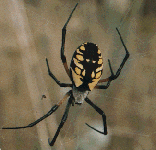Scientists unveil Spider-Man's secret
 A group of German and Swiss scientists have found out how the spiders managed to hold themselves on a straight vertical walls and ceilings.
A group of German and Swiss scientists have found out how the spiders managed to hold themselves on a straight vertical walls and ceilings.
During their experiments, the researchers studied the structure of the pads of spider Evarcha arcuata with a mighty magnification, Science Daily reports referring to the scientific journal “Smart Materials and Structures”.
It turned out that every pad has a small space consisting of the thinnest fuzzes. Each fuzz in its turn consists of tens thousand even more thin seta’s which are able to interact with a surface at molecular level with the help of van der Vaals forces.
The latter have got a very small energy (about 40 kJ/mol) and do not often display themselves at the background of some more powerful forces. However, though every particular fuzz does not make the necessary adhesion, the total attractive force of hundreds thousand seta’s is strong enough. In particular 600 thousand small fuzzes let the spider hang over the ceiling holding the weight 170 times heavier than its own.
The scientists’ discovery is expected to create fundamentally new materials in the future which will be used for making mountain-climber’s gloves, gummed tape with super-high adhesion, a special plaster to treat cuts, suits for cosmonauts and so on.
It is also worth mentioning that the spiders are not the only creatures on our planet who use van der Vaals forces during movement. In fact, the extremities of small gecko lizards have got a similar construction. They are covered with millions of smallest seta’s joined to the surface at molecular level.
Translated by: Irina Alexeyeva
Subscribe to Pravda.Ru Telegram channel, Facebook, RSS!





